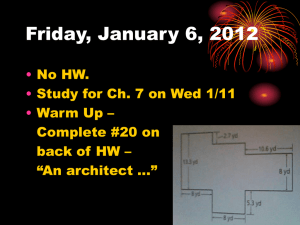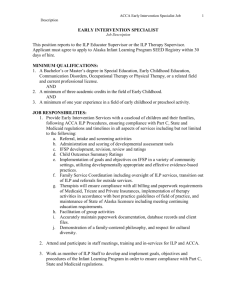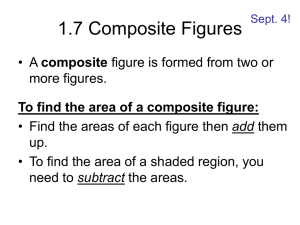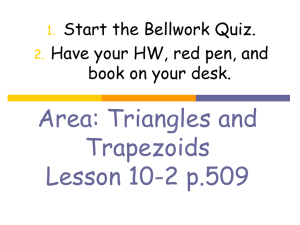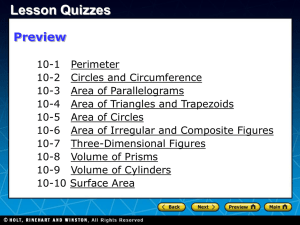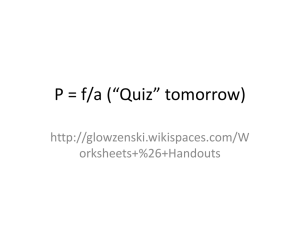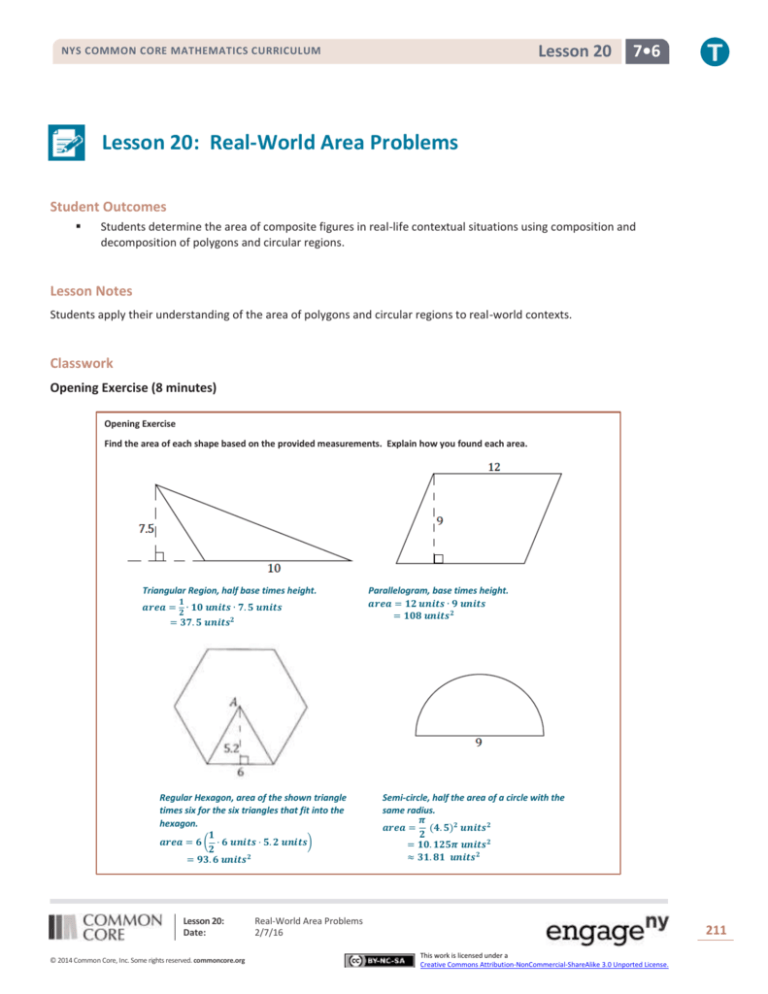
Lesson 20
NYS COMMON CORE MATHEMATICS CURRICULUM
7•6
Lesson 20: Real-World Area Problems
175
Student Outcomes
Students determine the area of composite figures in real-life contextual situations using composition and
decomposition of polygons and circular regions.
Lesson Notes
Students apply their understanding of the area of polygons and circular regions to real-world contexts.
Classwork
Opening Exercise (8 minutes)
Opening Exercise
Find the area of each shape based on the provided measurements. Explain how you found each area.
Triangular Region, half base times height.
𝒂𝒓𝒆𝒂 =
𝟏
∙ 𝟏𝟎 𝒖𝒏𝒊𝒕𝒔 ∙ 𝟕. 𝟓 𝒖𝒏𝒊𝒕𝒔
𝟐
= 𝟑𝟕. 𝟓 𝒖𝒏𝒊𝒕𝒔𝟐
Regular Hexagon, area of the shown triangle
times six for the six triangles that fit into the
hexagon.
𝟏
𝒂𝒓𝒆𝒂 = 𝟔 ( ⋅ 𝟔 𝒖𝒏𝒊𝒕𝒔 ⋅ 𝟓. 𝟐 𝒖𝒏𝒊𝒕𝒔)
𝟐
= 𝟗𝟑. 𝟔 𝒖𝒏𝒊𝒕𝒔𝟐
Lesson 20:
Date:
© 2014 Common Core, Inc. Some rights reserved. commoncore.org
Parallelogram, base times height.
𝒂𝒓𝒆𝒂 = 𝟏𝟐 𝒖𝒏𝒊𝒕𝒔 ∙ 𝟗 𝒖𝒏𝒊𝒕𝒔
= 𝟏𝟎𝟖 𝒖𝒏𝒊𝒕𝒔𝟐
Semi-circle, half the area of a circle with the
same radius.
𝝅
𝒂𝒓𝒆𝒂 = (𝟒. 𝟓)𝟐 𝒖𝒏𝒊𝒕𝒔𝟐
𝟐
= 𝟏𝟎. 𝟏𝟐𝟓𝝅 𝒖𝒏𝒊𝒕𝒔𝟐
≈ 𝟑𝟏. 𝟖𝟏 𝒖𝒏𝒊𝒕𝒔𝟐
Real-World Area Problems
2/7/16
211
This work is licensed under a
Creative Commons Attribution-NonCommercial-ShareAlike 3.0 Unported License.
Lesson 20
NYS COMMON CORE MATHEMATICS CURRICULUM
7•6
Example 1 (10 minutes)
Students should first attempt this question without assistance. Once students have had time to work on their own, lead
the class through a discussion using the following prompts according to student need.
Example 1
A landscape company wants to plant lawn seed. A 𝟐𝟎 lb. bag of
lawn seed will cover up to 𝟒𝟐𝟎 sq. ft. of grass and costs $𝟒𝟗. 𝟗𝟖
plus the 𝟖% sales tax. A scale drawing of a rectangular yard is
given. The length of the longest side is 𝟏𝟎𝟎 ft. The house,
driveway, sidewalk, garden areas, and utility pad are shaded. The
unshaded area has been prepared for planting grass. How many 𝟐𝟎
lb. bags of lawn seed should be ordered, and what is the cost?
𝐴2
𝐴3
𝐴1
𝐴4
𝐴7
𝐴6
𝐴5
The following calculations demonstrate how to find the area of the lawn by subtracting the area of the home
from the area of the entire yard.
Non-grassy sections in the map of the yard and their areas.
𝐴1 = 4 𝑢𝑛𝑖𝑡𝑠 ∙ 4 𝑢𝑛𝑖𝑡𝑠 = 16 𝑢𝑛𝑖𝑡𝑠 2
𝐴2 = 1 𝑢𝑛𝑖𝑡𝑠 ∙ 13 𝑢𝑛𝑖𝑡𝑠 = 13 𝑢𝑛𝑖𝑡𝑠 2
𝐴3 = 7 𝑢𝑛𝑖𝑡𝑠 ∙ 13 𝑢𝑛𝑖𝑡𝑠 = 91 𝑢𝑛𝑖𝑡𝑠 2
𝐴4 = 1 𝑢𝑛𝑖𝑡𝑠 ∙ 6 𝑢𝑛𝑖𝑡𝑠 = 6 𝑢𝑛𝑖𝑡𝑠 2
𝐴5 = 6 𝑢𝑛𝑖𝑡𝑠 ∙ 1 𝑢𝑛𝑖𝑡𝑠 = 6 𝑢𝑛𝑖𝑡𝑠 2
𝐴6 = 1 𝑢𝑛𝑖𝑡𝑠 ∙ 6 𝑢𝑛𝑖𝑡𝑠 = 6 𝑢𝑛𝑖𝑡𝑠 2
𝐴7 = 2 𝑢𝑛𝑖𝑡𝑠 ∙ 1 𝑢𝑛𝑖𝑡𝑠 = 2 𝑢𝑛𝑖𝑡𝑠 2
MP.2
The scale of the map is 5 ft. for every one unit and 25 ft2 for every 1 unit2.
What is the grassy area in square feet?
Subtract the area of the non-grassy sections from the area of the yard.
𝐴 = (20 𝑢𝑛𝑖𝑡𝑠 ∙ 18 𝑢𝑛𝑖𝑡𝑠) − 140 𝑢𝑛𝑖𝑡𝑠 2 = 220 𝑢𝑛𝑖𝑡𝑠 2
What is the scale factor of the map of the yard?
𝐴1 + 𝐴2 + 𝐴3 + 𝐴4 + 𝐴5 + 𝐴6 + 𝐴7 = 16 𝑢𝑛𝑖𝑡𝑠 2 + 13 𝑢𝑛𝑖𝑡𝑠 2 + 91 𝑢𝑛𝑖𝑡𝑠 2 + 6 𝑢𝑛𝑖𝑡𝑠 2 +
6 𝑢𝑛𝑖𝑡𝑠 2 + 6 𝑢𝑛𝑖𝑡𝑠 2 + 2 𝑢𝑛𝑖𝑡𝑠 2 = 140 𝑢𝑛𝑖𝑡𝑠 2
What is the area of the grassy section of the yard?
An alternative image with
fewer regions is provided
after the initial solution.
What is the total area of the non-grassy sections?
Scaffolding:
220 ⋅ 25 = 5,500
If one 20 lb. bag covers 420 square feet, write a numerical expression for the number of bags needed to cover
the grass in the yard. Explain your expression.
Grassy area ÷ area that one bag of seed covers
5,500 ÷ 420
Lesson 20:
Date:
© 2014 Common Core, Inc. Some rights reserved. commoncore.org
Real-World Area Problems
2/7/16
212
This work is licensed under a
Creative Commons Attribution-NonCommercial-ShareAlike 3.0 Unported License.
Lesson 20
NYS COMMON CORE MATHEMATICS CURRICULUM
MP.2
7•6
How many bags are needed to cover the grass in the yard?
5,500 ÷ 420 ≈ 13.1
It will take 14 bags to seed the yard.
What is the final cost of seeding the yard?
1.08 ⋅ 14 ⋅ $49.98 ≈ $755.70
Final cost with sales tax is $755.70
Encourage students to write or state an explanation for how they solved the problem.
Alternative image of property:
100 ft.
Non-grassy sections in the map of the yard and their areas.
𝐴1 = 14 𝑢𝑛𝑖𝑡𝑠 ∙ 14 𝑢𝑛𝑖𝑡𝑠 = 196 𝑢𝑛𝑖𝑡𝑠 2
𝐴2 = 4 𝑢𝑛𝑖𝑡𝑠 ∙ 8 𝑢𝑛𝑖𝑡𝑠 = 32 𝑢𝑛𝑖𝑡𝑠 2
What is the total area of the non-grassy sections?
𝐴1 + 𝐴2 = 196 𝑢𝑛𝑖𝑡𝑠 2 + 32 𝑢𝑛𝑖𝑡𝑠 2 = 228 𝑢𝑛𝑖𝑡𝑠 2
What is the area of the grassy section of the yard?
Subtract the area of the non-grassy sections from the area of the yard.
𝐴 = (20 𝑢𝑛𝑖𝑡𝑠 ∙ 15 𝑢𝑛𝑖𝑡𝑠) − 228 𝑢𝑛𝑖𝑡𝑠 2 = 72 𝑢𝑛𝑖𝑡𝑠 2
What is the scale factor of the map of the yard?
The scale of the map is 5 ft. for every one unit and 25 ft2 for every 1 unit2.
What is the grassy area in square feet?
If one 20 lb. bag covers 420 square feet, write a numerical expression for the number of bags needed to cover
the grass in the yard. Explain your expression.
MP.2
72 ⋅ 25 = 1,800
Grassy area ÷ area that one bag of seed covers
1,800 ÷ 420
How many bags are needed to cover the grass in the yard?
1,800 ÷ 420 ≈ 4.3
It will take 5 bags to seed the yard.
What is the final cost of seeding the yard?
1.08 ⋅ 5 ⋅ $49.98 ≈ $269.89
Final cost with sales tax is $269.89.
Lesson 20:
Date:
© 2014 Common Core, Inc. Some rights reserved. commoncore.org
Real-World Area Problems
2/7/16
213
This work is licensed under a
Creative Commons Attribution-NonCommercial-ShareAlike 3.0 Unported License.
Lesson 20
NYS COMMON CORE MATHEMATICS CURRICULUM
7•6
Exercise 1 (6 minutes)
Exercise 1
A landscape contractor looks at a scale drawing of a yard and estimates that the area of the home and garage is the same
as the area of a rectangle that is 𝟏𝟎𝟎 ft. × 𝟑𝟓 ft. The contractor comes up with 𝟓, 𝟓𝟎𝟎 ft2. How close is this estimate?
The entire yard (home and garage) has an area of 𝟏𝟎𝟎 ft. × 𝟑𝟓 ft. = 𝟑, 𝟓𝟎𝟎 ft2. The contractor’s estimate is 𝟓, 𝟓𝟎𝟎 ft2.
He is 𝟐, 𝟎𝟎𝟎 ft2 over the actual area, which is quite a bit more (𝟐, 𝟎𝟎𝟎 ft2 is roughly 𝟓𝟕% of the actual area).
Example 2 (10 minutes)
Example 2
Ten dartboard targets are being painted as shown in the following figure. The
radius of the smallest circle is 𝟑 in. and each successive, larger circle is 𝟑 in.
more in radius than the circle before it. A “tester” can of red and of white paint
is purchased to paint the target. Each 𝟖 oz. can of paint covers 𝟏𝟔 ft2. Is there
enough paint of each color to create all ten targets?
C4
Let each circle be labeled as in the diagram.
C3 C
2 C
1
Radius of 𝑪𝟏 is 𝟑 in.; area of 𝑪𝟏 is 𝟗𝝅 in2.
Radius of 𝑪𝟐 is 𝟔 in.; area of 𝑪𝟐 is 𝟑𝟔𝝅 in2.
Radius of 𝑪𝟑 is 𝟗 in.; area of 𝑪𝟑 is 𝟖𝟏𝝅 in2.
Radius of 𝑪𝟒 is 𝟏𝟐 in.; area of 𝑪𝟒 is 𝟏𝟒𝟒𝝅 in2.
MP.2
&
MP.7
Write a numerical expression that represents the area painted red. Explain how your expression represents
the situation.
The area of red and white paint in square inches is found by finding the area between circles of the
target board:
Red paint: (144𝜋 in2 − 81𝜋 in2) + (36𝜋 in2 − 9𝜋 in2)
White paint: (81𝜋 in2 − 36𝜋 in2) + 9𝜋 in2
The following calculations demonstrate how to find the area of red and white paint in the target.
Target area painted red
The area between 𝑪𝟒 and 𝑪𝟑 :
𝟏𝟒𝟒𝝅 in2 − 𝟖𝟏𝝅 in2 = 𝟔𝟑𝝅 in2
The area between 𝑪𝟐 and 𝑪𝟏 :
𝟑𝟔𝝅 in2 − 𝟗𝝅 in2 = 𝟐𝟕𝝅 in2
Area painted red in one target:
𝟔𝟑𝝅 in2 +𝟐𝟕𝝅 in2 = 𝟗𝟎𝝅 in2; approximately 𝟐𝟖𝟐. 𝟕 in2
Area of red paint for one target in sq. ft.:
𝟐𝟖𝟐. 𝟕 𝒊𝒏𝟐 (
Area to be painted red for ten targets in sq. ft.:
𝟏. 𝟗𝟔 ft2 × 𝟏𝟎 = 𝟏𝟗. 𝟔 ft2
Lesson 20:
Date:
© 2014 Common Core, Inc. Some rights reserved. commoncore.org
𝟐
𝟏 𝒇𝒕
𝟏𝟒𝟒 𝒊𝒏𝟐
) ≈ 𝟏. 𝟗𝟔 𝒇𝒕𝟐
Real-World Area Problems
2/7/16
214
This work is licensed under a
Creative Commons Attribution-NonCommercial-ShareAlike 3.0 Unported License.
Lesson 20
NYS COMMON CORE MATHEMATICS CURRICULUM
7•6
Target area painted white
The area between 𝑪𝟑 and 𝑪𝟐 :
𝟖𝟏𝝅 in2 −𝟑𝟔𝝅 in2 = 𝟒𝟓𝝅 in2
The area of 𝑪𝟏 :
𝟗𝝅 in2
Area painted white in one target:
𝟒𝟓𝝅 in2 +𝟗𝝅 in2 = 𝟓𝟒𝝅 in2; approximately 𝟏𝟔𝟗. 𝟔 in2
Area of white paint for one target sq. ft.:
𝟏𝟔𝟗. 𝟔 𝒊𝒏𝟐 (
Area of white paint needed for ten targets in sq. ft.:
𝟏. 𝟏𝟖 ft2 × 𝟏𝟎 = 𝟏𝟏. 𝟖 ft2
𝟐
𝟏 𝒇𝒕
𝟏𝟒𝟒 𝒊𝒏
𝟐)
≈ 𝟏. 𝟏𝟖 𝒇𝒕𝟐
There is not enough red paint in one tester can of paint to complete all ten targets; however, there is enough white paint
in one tester can of paint for all ten targets.
Closing (2 minutes)
What is a useful strategy when tackling area problems with real-world context?
Decompose drawings into familiar polygons and circular regions, and identify all relevant
measurements.
Pay attention to the unit needed in a response to each question.
Exit Ticket (9 minutes)
Lesson 20:
Date:
© 2014 Common Core, Inc. Some rights reserved. commoncore.org
Real-World Area Problems
2/7/16
215
This work is licensed under a
Creative Commons Attribution-NonCommercial-ShareAlike 3.0 Unported License.
Lesson 20
NYS COMMON CORE MATHEMATICS CURRICULUM
Name
7•6
Date
Lesson 20: Real-World Area Problems
Exit Ticket
A homeowner called in a painter to paint bedroom walls and ceiling. The bedroom is 18 ft. long, 12 ft. wide, and 8 ft.
high. The room has two doors each 3 ft. by 7 ft. and three windows each 3 ft. by 5 ft. The doors and windows do not
have to be painted. A gallon of paint can cover 300 ft2. A hired painter claims he will need 4 gal. Show that the
estimate is too high.
Lesson 20:
Date:
© 2014 Common Core, Inc. Some rights reserved. commoncore.org
Real-World Area Problems
2/7/16
216
This work is licensed under a
Creative Commons Attribution-NonCommercial-ShareAlike 3.0 Unported License.
Lesson 20
NYS COMMON CORE MATHEMATICS CURRICULUM
7•6
Exit Ticket Sample Solutions
A homeowner called in a painter to paint bedroom walls and ceiling. The bedroom is 𝟏𝟖 ft. long, 𝟏𝟐 ft. wide, and 𝟖 ft.
high. The room has two doors each 𝟑 ft. by 𝟕 ft. and three windows each 𝟑 ft. by 𝟓 ft. The doors and windows do not
have to be painted. A gallon of paint can cover 𝟑𝟎𝟎 ft2. A hired painter claims he will need 𝟒 gal. Show that the estimate
is too high.
Area of 2 walls:
𝟐(𝟏𝟖 ft. ∙ 𝟖 ft.) = 𝟐𝟖𝟖 ft2
Area of remaining 2 walls:
𝟐(𝟏𝟐 ft. ∙ 𝟖 ft.) = 𝟏𝟗𝟐 ft2
Area of ceiling:
𝟏𝟖 ft. ∙ 𝟏𝟐 ft. = 𝟐𝟏𝟔 ft2
Area of 2 doors:
𝟐(𝟑 ft. ∙ 𝟕 ft. ) = 𝟒𝟐 ft2
Area of 3 windows
𝟑(𝟑 ft. ∙ 𝟓 ft. ) = 𝟒𝟓 ft2
Area to be painted:
(𝟐𝟖𝟖 ft2 + 𝟏𝟗𝟐 ft2 + 𝟐𝟏𝟔 ft2 ) − (𝟒𝟐 ft2 + 𝟒𝟓 ft2 ) = 𝟔𝟎𝟗 ft2
Gallons of paint needed:
𝟔𝟎𝟗 ÷ 𝟑𝟎𝟎 = 𝟐. 𝟎𝟑 The painter will need a little more than 𝟐 gal.
The painter’s estimate for how much paint is necessary was too high.
Problem Set Sample Solutions
1.
A farmer has four pieces of unfenced land as shown
below in the scale drawing where the dimensions of
one side are given. The farmer trades all of the land
and $𝟏𝟎, 𝟎𝟎𝟎 for 𝟖 acres of similar land that is fenced.
If one acre is equal to 𝟒𝟑, 𝟓𝟔𝟎 ft2, how much per
square foot for the extra land did the farmer pay
rounded to the nearest cent?
𝟏
𝟐
𝐴1
𝐴3
𝑨𝟏 = (𝟔 𝒖𝒏𝒊𝒕𝒔 ∙ 𝟒 𝒖𝒏𝒊𝒕𝒔) = 𝟏𝟐 𝒖𝒏𝒊𝒕𝒔𝟐
𝐴2
𝐴4
𝟏
𝟐
𝑨𝟐 = (𝟔 𝒖𝒏𝒊𝒕𝒔 + 𝟕 𝒖𝒏𝒊𝒕𝒔)(𝟒 𝒖𝒏𝒊𝒕𝒔) = 𝟐𝟔 𝒖𝒏𝒊𝒕𝒔𝟐
𝑨𝟑 = (𝟑 𝒖𝒏𝒊𝒕𝒔 ∙ 𝟔 𝒖𝒏𝒊𝒕𝒔) + (𝟑 𝒖𝒏𝒊𝒕𝒔 ∙ 𝟓 𝒖𝒏𝒊𝒕𝒔) = 𝟑𝟑 𝒖𝒏𝒊𝒕𝒔𝟐
𝟏
𝟐
𝑨𝟒 = (𝟒 𝒖𝒏𝒊𝒕𝒔 ∙ 𝟕 𝒖𝒏𝒊𝒕𝒔) + (𝟑 𝒖𝒏𝒊𝒕𝒔 ∙ 𝟑 𝒖𝒏𝒊𝒕𝒔) + (𝟑 𝒖𝒏𝒊𝒕𝒔 ∙ 𝟒 𝒖𝒏𝒊𝒕𝒔) = 𝟒𝟑 𝒖𝒏𝒊𝒕𝒔𝟐
The sum of the farmer’s four pieces of land:
𝑨𝟏 + 𝑨𝟐 + 𝑨𝟑 + 𝑨𝟒 = 𝟏𝟐 𝒖𝒏𝒊𝒕𝒔𝟐 + 𝟐𝟔 𝒖𝒏𝒊𝒕𝒔𝟐 + 𝟑𝟑 𝒖𝒏𝒊𝒕𝒔𝟐 + 𝟒𝟑 𝒖𝒏𝒊𝒕𝒔𝟐 = 𝟏𝟏𝟒 𝒖𝒏𝒊𝒕𝒔𝟐
The sum of the farmer’s four pieces of land in sq. ft.:
𝟔 units = 𝟑𝟎𝟎 ft. divide each side by 𝟔
𝟏 unit = 𝟓𝟎 ft. and 𝟏 unit2 = 𝟐, 𝟓𝟎𝟎 ft2
𝟏𝟏𝟒 ⋅ 𝟐, 𝟓𝟎𝟎 = 𝟐𝟖𝟓, 𝟎𝟎𝟎
The total area of the farmer's four pieces of land: 𝟐𝟖𝟓, 𝟎𝟎𝟎 ft2.
Lesson 20:
Date:
© 2014 Common Core, Inc. Some rights reserved. commoncore.org
Real-World Area Problems
2/7/16
217
This work is licensed under a
Creative Commons Attribution-NonCommercial-ShareAlike 3.0 Unported License.
Lesson 20
NYS COMMON CORE MATHEMATICS CURRICULUM
7•6
The sum of the farmer’s four pieces of land in acres:
𝟐𝟖𝟓, 𝟎𝟎𝟎 ÷ 𝟒𝟑, 𝟓𝟔𝟎 ≈ 𝟔. 𝟓𝟒
The farmer’s four pieces of land total about 𝟔. 𝟓𝟒 acres.
Extra land purchased with $𝟏𝟎, 𝟎𝟎𝟎: 𝟖 acres − 𝟔. 𝟓𝟒 acres = 𝟏. 𝟒𝟔 acres
Extra land in square feet:
𝟒𝟑, 𝟓𝟔𝟎 𝒇𝒕𝟐
𝟏. 𝟒𝟔 𝒂𝒄𝒓𝒆𝒔 (
) ≈ 𝟔𝟑, 𝟓𝟗𝟕. 𝟔 𝒇𝒕𝟐
𝟏 𝒂𝒄𝒓𝒆
Price per square foot for extra land:
$𝟏𝟎, 𝟎𝟎𝟎
(
) ≈ $𝟎. 𝟏𝟔
𝟔𝟑, 𝟓𝟗𝟕. 𝟔 𝒇𝒕𝟐
2.
An ordinance was passed that required farmers to put a fence around their property. The least expensive fences
cost $𝟏𝟎 for each foot. Did the farmer save money by moving the farm?
At $𝟏𝟎 for each foot, $𝟏𝟎, 𝟎𝟎𝟎 would purchase 𝟏, 𝟎𝟎𝟎 feet of fencing. The perimeter of the third piece of land
(labeled 𝑨𝟑 ) has perimeter 𝟏, 𝟐𝟎𝟎 ft. So it would have cost over $𝟏𝟎, 𝟎𝟎𝟎 just to fence that piece of property. The
farmer did save money by moving the farm.
3.
A stop sign is an octagon (i.e., a polygon with eight sides) with eight equal sides and eight equal angles. The
dimensions of the octagon are given. One side of the stop sign is to be painted red. If Timmy has enough paint to
paint 𝟓𝟎𝟎 ft2, can he paint 𝟏𝟎𝟎 stop signs? Explain your answer.
𝟏
𝟐
area of top trapezoid= (𝟏𝟐 in. + 𝟐𝟗 in.)(𝟖. 𝟓 in.) = 𝟏𝟕𝟒. 𝟐𝟓 in2
area of middle rectangle = 𝟏𝟐 in. ∙ 𝟐𝟗 in. = 𝟑𝟒𝟖 in2
𝟏
𝟐
area of bottom trapezoid = (𝟏𝟐 in.+ 𝟐𝟗 in.)(𝟖. 𝟓 in.) = 𝟏𝟕𝟒. 𝟐𝟓 in2
Total area of stop sign in square inches:
𝑨𝟏 + 𝑨𝟐 + 𝑨𝟑 = 𝟏𝟕𝟒. 𝟐𝟓 in2 + 𝟑𝟒𝟖 in2 + 𝟏𝟕𝟒. 𝟐𝟓 in2 = 𝟔𝟗𝟔. 𝟓 in2
Total area of stop sign in square feet:
𝟔𝟗𝟔. 𝟓 𝒊𝒏𝟐 (
𝟐
𝟏 𝒇𝒕
𝟏𝟒𝟒 𝒊𝒏𝟐
) ≈ 𝟒. 𝟖𝟒 𝒇𝒕𝟐
Yes, the area of one stop sign is less than 𝟓 ft2 (𝟒. 𝟖𝟒 ft2). Therefore, 𝟏𝟎𝟎 stop signs would be less than 𝟓𝟎𝟎 ft2.
𝐴1
𝐴2
𝐴3
Lesson 20:
Date:
© 2014 Common Core, Inc. Some rights reserved. commoncore.org
Real-World Area Problems
2/7/16
218
This work is licensed under a
Creative Commons Attribution-NonCommercial-ShareAlike 3.0 Unported License.
Lesson 20
NYS COMMON CORE MATHEMATICS CURRICULUM
4.
7•6
The Smith family is renovating a few aspects of their home. The following diagram is of a new kitchen countertop.
Approximately how many square feet of counter space is there?
𝐴1
𝐴2
𝑨𝟏 = (𝟐𝟎 𝒊𝒏. +𝟏𝟔 𝒊𝒏. )(𝟏𝟖 𝒊𝒏. +𝟏𝟒 𝒊𝒏. ) = 𝟏, 𝟏𝟓𝟐 𝒊𝒏𝟐
𝟏
𝑨𝟐 = (𝟏𝟖 𝒊𝒏.∙ 𝟕 𝒊𝒏. ) + (𝟒𝟗𝝅 𝒊𝒏𝟐 )
𝟐
≈ (𝟏𝟐𝟔 𝒊𝒏𝟐 + 𝟕𝟕 𝒊𝒏𝟐 )
= 𝟐𝟎𝟑 𝒊𝒏𝟐
𝐴3) = 𝟓𝟐𝟖 𝒊𝒏𝟐
𝑨𝟑 = (𝟓𝟎 𝒊𝒏.∙ 𝟏𝟔 𝒊𝒏. ) − (𝟏𝟕 𝒊𝒏.∙ 𝟏𝟔 𝒊𝒏.
Total area of counter space in square inches:
𝑨𝟏 + 𝑨𝟐 + 𝑨𝟑 ≈ 𝟏, 𝟏𝟓𝟐 𝒊𝒏𝟐 + 𝟐𝟎𝟑 𝒊𝒏𝟐 + 𝟓𝟐𝟖 𝒊𝒏𝟐
𝑨𝟏 + 𝑨𝟐 + 𝑨𝟑 ≈ 𝟏, 𝟖𝟖𝟑 𝒊𝒏𝟐
Total area of counter-space in square feet:
𝟏 𝒇𝒕𝟐
𝟏, 𝟖𝟖𝟑 𝒊𝒏𝟐 (
) ≈ 𝟏𝟑. 𝟏 𝒇𝒕𝟐
𝟏𝟒𝟒 𝒊𝒏𝟐
There is approximately 𝟏𝟑. 𝟏 ft2 of counter space.
Lesson 20:
Date:
© 2014 Common Core, Inc. Some rights reserved. commoncore.org
Real-World Area Problems
2/7/16
219
This work is licensed under a
Creative Commons Attribution-NonCommercial-ShareAlike 3.0 Unported License.
Lesson 20
NYS COMMON CORE MATHEMATICS CURRICULUM
5.
7•6
In addition to the kitchen renovation, the Smiths’ are laying down new carpet. Everything but closets, bathrooms,
and the kitchen will have new carpet. How much carpeting must be purchased for the home?
𝐴5
𝐴2
𝐴1
𝐴4
𝐴6
𝐴3
𝑨𝟏 = (𝟗 𝒖𝒏𝒊𝒕𝒔 ∙ 𝟕 𝒖𝒏𝒊𝒕𝒔) + 𝟑 𝒖𝒏𝒊𝒕𝒔𝟐 = 𝟔𝟔 𝒖𝒏𝒊𝒕𝒔𝟐
𝑨𝟐 = (𝟔 𝒖𝒏𝒊𝒕𝒔 ∙ 𝟕 𝒖𝒏𝒊𝒕𝒔) − 𝟒 𝒖𝒏𝒊𝒕𝒔𝟐 = 𝟑𝟖 𝒖𝒏𝒊𝒕𝒔𝟐
𝑨𝟑 = (𝟔 𝒖𝒏𝒊𝒕𝒔 ∙ 𝟕 𝒖𝒏𝒊𝒕𝒔) − 𝟒 𝒖𝒏𝒊𝒕𝒔𝟐 = 𝟑𝟖 𝒖𝒏𝒊𝒕𝒔𝟐
𝑨𝟒 = 𝟐 𝒖𝒏𝒊𝒕𝒔 ∙ 𝟏𝟏 𝒖𝒏𝒊𝒕𝒔 = 𝟐𝟐 𝒖𝒏𝒊𝒕𝒔𝟐
𝑨𝟓 = (𝟓 𝒖𝒏𝒊𝒕𝒔 ∙ 𝟑 𝒖𝒏𝒊𝒕𝒔) + (𝟒 𝒖𝒏𝒊𝒕𝒔 ∙ 𝟔 𝒖𝒏𝒊𝒕𝒔) = 𝟑𝟗 𝒖𝒏𝒊𝒕𝒔𝟐
𝑨𝟔 = 𝟓 𝒖𝒏𝒊𝒕𝒔 ∙ 𝟖 𝒖𝒏𝒊𝒕𝒔 = 𝟒𝟎 𝒖𝒏𝒊𝒕𝒔𝟐
Total area that needs carpeting:
𝑨𝟏 + 𝑨𝟐 + 𝑨𝟑 + 𝑨𝟒 + 𝑨𝟓 + 𝑨𝟔 = 𝟔𝟔 𝒖𝒏𝒊𝒕𝒔𝟐 + 𝟑𝟖 𝒖𝒏𝒊𝒕𝒔𝟐 + 𝟑𝟖 𝒖𝒏𝒊𝒕𝒔𝟐 + 𝟐𝟐 𝒖𝒏𝒊𝒕𝒔𝟐 + 𝟑𝟗 𝒖𝒏𝒊𝒕𝒔𝟐 + 𝟒𝟎 𝒖𝒏𝒊𝒕𝒔𝟐
= 𝟐𝟒𝟑 𝒖𝒏𝒊𝒕𝒔𝟐
Scale factor: 𝟏 𝒖𝒏𝒊𝒕 = 𝟐 𝒇𝒕.; 𝟏 𝒖𝒏𝒊𝒕𝟐 = 𝟒 𝒇𝒕𝟐.
Total area that needs carpeting in square feet:
𝟒 𝒇𝒕𝟐
𝟐𝟒𝟑 𝒖𝒏𝒊𝒕𝒔𝟐 (
) = 𝟗𝟕𝟐 𝒇𝒕𝟐
𝟏 𝒖𝒏𝒊𝒕𝟐
6.
𝟏
𝟐
Jamie wants to wrap a rectangular sheet of paper completely around cans that are 𝟖 in. high and 𝟒 in. in diameter.
𝟏
𝟐
She can buy a roll of paper that is 𝟖 in. wide and 𝟔𝟎 ft. long. How many cans will this much paper wrap?
𝟒 inch diameter cans have a circumference of 𝟒𝝅 in., approximately 𝟏𝟐. 𝟓𝟕 in. 𝟔𝟎 ft. is the same as 𝟕𝟐𝟎 in.;
𝟕𝟐𝟎 in. ÷ 𝟏𝟐. 𝟓𝟕 in. is approximately 𝟓𝟕. 𝟑 in., so this paper will cover 𝟓𝟕 cans.
Lesson 20:
Date:
© 2014 Common Core, Inc. Some rights reserved. commoncore.org
Real-World Area Problems
2/7/16
220
This work is licensed under a
Creative Commons Attribution-NonCommercial-ShareAlike 3.0 Unported License.

